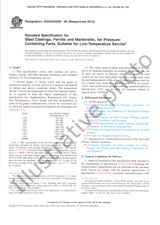We need your consent to use the individual data so that you can see information about your interests, among other things. Click "OK" to give your consent.
ASTM F25/F25M-21
Standard Test Method for Sizing and Counting Airborne Particulate Contamination in Cleanrooms and Other Dust-Controlled Areas
Translate name
STANDARD published on 1.4.2021
The information about the standard:
Designation standards: ASTM F25/F25M-21
Publication date standards: 1.4.2021
SKU: NS-1023156
The number of pages: 8
Approximate weight : 24 g (0.05 lbs)
Country: American technical standard
Category: Technical standards ASTM
The category - similar standards:
Annotation of standard text ASTM F25/F25M-21 :
This test method covers the apparatuses required, sampling methods, standard procedures and calculations, and test reports for counting and sizing airborne microparticulate matter, the sampling areas for which are specifically those with contamination levels typical of cleanrooms and dust-controlled areas. The test method is based on the microscopical examination of particles impinged upon a membrane filter with the aid of a vacuum. Sampling may be done in a cleanroom, clean zone, or other controlle areas, or in a duct or pipe, wherein the number of sampling points is proportional to the floor area of the enclosure to be checked. The apparatus and facilities required are typical of a laboratory for the study of macroparticle contamination. The operator must have adequate basic training in microscopy and the techniques of particle sizing and counting.
Keywords:
airborne particle concentration, cleanroom, contamination, macroparticle ,, ICS Number Code 13.040.30 (Workplace atmospheres)
Additional information
| 1. Scope | ||||||||
|
1.1?This test method covers counting and sizing airborne particulate matter 5 ?m and larger (macroparticles). The sampling areas are specifically those with contamination levels typical of cleanrooms and dust-controlled areas. 1.2?UnitsThe values stated in either SI units or inch-pound units are to be regarded separately as standard. The values stated in each system are not necessarily exact equivalents; therefore, to ensure conformance with the standard, each system shall be used independently of the other, and values from the two systems shall not be combined. 1.3?This standard does not purport to address all of the safety concerns, if any, associated with its use. It is the responsibility of the user of this standard to establish appropriate safety, health, and environmental practices and determine the applicability of regulatory limitations prior to use. 1.4?This international standard was developed in accordance with internationally recognized principles on standardization established in the Decision on Principles for the Development of International Standards, Guides and Recommendations issued by the World Trade Organization Technical Barriers to Trade (TBT) Committee. |
||||||||
| 2. Referenced Documents | ||||||||
|
We recommend:
Technical standards updating
Do you want to make sure you use only the valid technical standards?
We can offer you a solution which will provide you a monthly overview concerning the updating of standards which you use.
Would you like to know more? Look at this page.




 Cookies
Cookies
